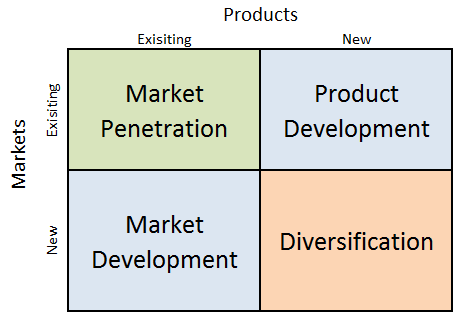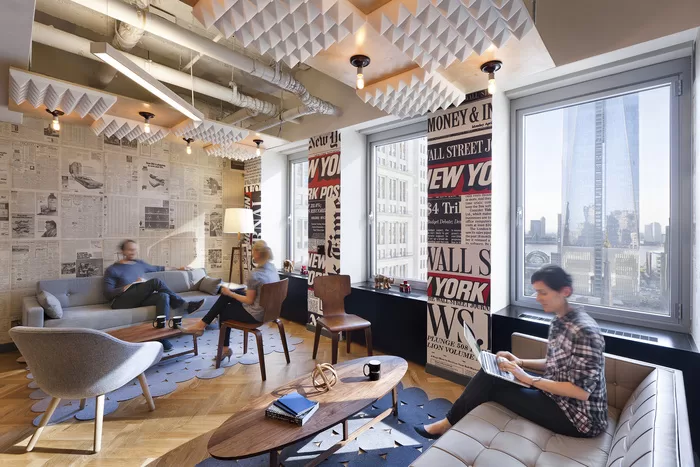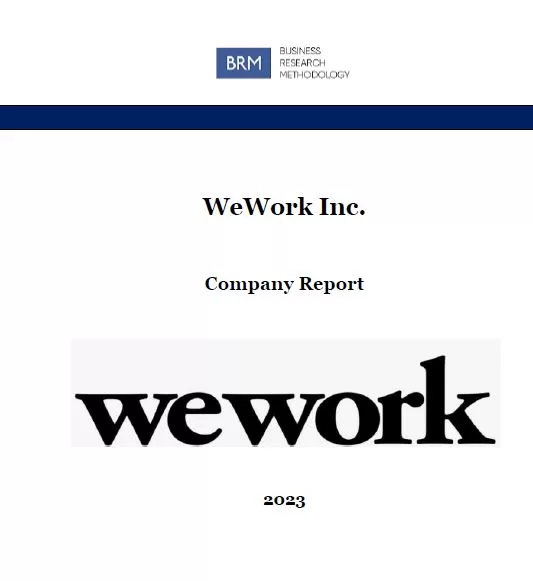Posts by John Dudovskiy

Co-founder and former CEO Adam Neumann had a compelling vision for WeWork ecosystem. It has been noted that “Neumann has even expressed a desire to one day have entire WeWork communities, where everything from your apartment to the school your children attend is brought to you by WeWork”[1] The main components of the ecosystem as envisioned by Neumann include the following: WeGrow private school. The curriculum featuring ‘conscious entrepreneurship’, the school was actually the brand child of Adam Neumann’s wife Rebecah. WeGrow school closed only a year later after enrolling around 100 children in 2018 for the tuition cost of up to USD 42k.[2] WeMrkt physical store. Opened in 2010, WeMrkt physical store offered products such as Icelandic yogurt and chickpea snacks sourced from WeWork member companies. Powered by We. A range of services that transform data to design. These services include helping clients find the right physical space, construction, custom office decor, software to manage building operations, back-end data on the efficiency of the office space, and even WeWork employees physically on-site to help with community programs.[3] HQ by WeWork. Private and personalized headquarters for medium sized businesses. WeWork Labs. An initiative to assist early-stage start-ups with growth through education, mentorship, and an agile workspace. The program was shut down in 2022. Rise by We. A premium fitness concept presented as an ultimate wellness club. WeLive. Furnished, community-oriented shared living apartment suite rentals, offering amenities in select US metropolitan areas. Almost all of the initiatives listed above that were planned as important components as WeWork ecosystem have failed. However, it is important to note that in most cases the failure may not be an indication of flaw of respective ideas. Rather, the failure of these initiatives can be attributed to the following main two reasons: 1. Poor leadership. It is now…

WeWork marketing strategy is based on the following principles: 1. Effective use of social media marketing. The global flexible workspace provider efficiently uses social media marketing through viral marketing, localized Facebook ads appealing to the needs and wants of the local customer segment. Furthermore, there are many YouTube videos with positive customer testimonials for using WeWork co-working spaces with positive implications on the brand image. 2. Celebrity endorsement. Although the leadership style of the co-founder and former CEO Adam Neumann had proved to be devastating for the company, he was able to engage in celebrity endorsement in cost-effective manner. Celebrities such as Drake, Ashton Kutcher and Hugh Jackman were spotted in WeWork headquarters with positive implications to the brand image. The co-working giant continued with celebrity endorsement even after the departure of Neumann. 3. Focus on the product and place. Within the framework of 7Ps of marketing WeWork focuses on product and place elements of the marketing mix to a greater extend compared to other elements. The global flexible workspace provider offers workspace as a service – creatively designed, furnished, flexible and without long-term commitments. This is the unique selling proposition for WeWork. The co-working giant has a network of 756 locations worldwide, including 277 locations in the US as of December 2021. 4. Effective market segmentation and positioning. The co-working giant uses functional and multi-segment positioning techniques and targets customers mainly in urban areas in 38 countries worldwide. In terms of occupational segmentation criteria WeWork targets self-employed individuals, professionals, senior managers, executives and business owners. 5. Integrated use of marketing communication mix. The co-working and office space operator uses several marketing communication channels such as print and media advertising, sales promotions, events and experiences and public relations in integrated way to communicate marketing message to the target customer segment.…

WeWork PESTEL analysis is a strategic analytical tool and the acronym stands for political, economic, social, technological, environmental and legal factors affecting the global flexible workspace provider. Political Factors in WeWork PESTEL Analysis Political factors that can affect workspace providers such as WeWork are multiple and include government stability, tax policies, lobbying and level of bureaucracy. Co-working providers are also affected by corruption, freedom of press, activities of trade unions and other factors. Government stability Government stability plays an important role on the long-term growth prospects of WeWork. The global flexible workspace provider operates 756 locations in 38 countries[1]. Changes in government policies may impact WeWork’s ability to secure office space, enter in lease agreements and manage its workforce. Furthermore, government instability or war such us the one currently going on in Ukraine can result in the loss of WeWork properties with direct implications on the bottom line. Tax Policies WeWork is subject to tax policies in all 38 countries it operates. The co-working giant is directly affected by corporate taxes. The higher the corporate taxes, the higher is the cost of doing business in any particular region. Moreover, favourable treatment of leases in some countries increases the company’s profitability, considering that the workspace provider leases the majority of its locations. Despite its huge size, in the past WeWork had benefited from tax breaks intended for small businesses. Specifically, by 2019 the company had received about GBP 2 million tax refund on property taxes it had paid in UK.[2] Lobbying Lobbying can affect the performance and growth prospects of the global flexible workspace provider. It is an attempt by individuals or organizations to influence government decisions. Potentially lobbying can benefit co-working and flexible working sector through tax befits for leasing arrangements and providing other benefits…

SWOT is an acronym for strengths, weaknesses, opportunities and threats related to organizations. The following table illustrates WeWork SWOT analysis: Strengths 1. Strong liquidity 2. International presence 3. Experience 4. Brand recognition Weaknesses 1. Business has not achieved profitability 2. High level of indebtedness 3. Damaged company image 4. Business model easy to replicate Opportunities 1. Entering into strategic collaborations 2. Strengthening WeWork ecosystem 3. Finding new sources of competitive advantage 4. Increasing marketing efficiency Threats 1. Inability of Sandeep Mathrani to turn around the business 2. Members seeking payment concessions or deferrals or cancellations 3. Emergence of new competitors with innovative business models 4. Changes in customer attitudes towards shared workspace WeWork SWOT Analysis Strengths in WeWork SWOT Analysis 1. WeWork has a strong liquidity. As of December 31, 2021, the company had access to USD2.0 billion of liquidity in the form of cash and commitments from its lenders. Strong liquidity offers a range of benefits for the workspace provider such as ability to meet short-term debts and dealing with unforeseen circumstances. 2. The global flexible workspace provider operates a network of 756 locations in 38 countries as of December 2021. Global presence offers a range of advantages for the workspace provider. These include economies of scale, access to local talent and opportunity to increase revenues. 3. WeWork had to deal with a range of serious issues such as ineffective management, severely flawed corporate culture and starting many initiatives at the same time. These setbacks damaged the brand image to a considerable extent. At the same time, it can be argued that the process of having to go through these problems have been a valuable experience for employees at all levels. Specifically, thanks to these issues WeWork employees at all levels are more mature now and they…

WeWork Ansoff Matrix is a marketing planning model that helps co-working and office space operator to determine its product and market strategy. Ansoff Matrix illustrates four different strategy options available for businesses. These are market penetration, product development, market development and diversification. WeWork Ansoff Growth Matrix Within the scope of Ansoff Matrix, WeWork uses all four growth strategies in an integrated manner: 1. Market penetration. Market penetration refers to selling existing products to existing markets. WeWork engages in market penetration strategy extensively. The global flexible workspace provider uses print and media marketing in general and social media marketing in particular to increase its penetration into the market. 2. Product development. This involves developing new products to sell to existing markets. WeWork engages in new product development rarely. WeWork Workplace software for landlords for online booking of desks, offices, collaboration hubs, and meeting rooms is one of the very few noteworthy cases of new product development by the co-working giant. 3. Market development. Market development strategy is associated with finding new markets for existing products. New market development is one of the main growth strategies for WeWork. Starting only with one location in Manhattan, USA in 2011, the workspace provider has expanded to a network of 756 locations in 38 countries, including 277 locations in the US as of December 2021. 4. Diversification. Diversification involves developing new products to sell to new markets and this is considered to be the riskiest strategy. WeWork does not engage in diversification business strategy, but it may do so in the future. WeWork Inc. Report contains the above analysis of WeWork Ansoff Matrix. The report illustrates the application of the major analytical strategic frameworks in business studies such as SWOT, PESTEL, Porter’s Five Forces, Value Chain analysis and McKinsey 7S Model on WeWork. Moreover,…

A documentary released by Hulu on April 1st 2021 provides an insight on WeWork organizational culture and its serious shortcomings under the leadership of co-founder and former CEO Adam Neumann. At that time corporate culture at WeWork was notorious for ‘frat-boy’ culture, sexual abuse, motivational mantras and free beer. The co-working giant organized annual employee retreat on a remote island. The company engaged in tracking employees at mandatory, alcohol-fuelled company events and an onboarding process that made all new employees shout WeWork until red in the face. New CEO, real estate veteran Sandeep Mathrani who took helm in February 2020 brought maturity and discipline into the company with direct implications on organizational culture of WeWork. Dubbed as ‘anti-Adam Neumann’ the new CEO was quick to put a stop at extravagant company events and cut costs in many other ways. Under the new leadership the global flexible workspace provider has committed to zero tolerance to discrimination and abuse at workplace in any form and these changes are more than welcomed by stakeholders. Mr. Mathrani is committed to change the important components of WeWork organizational culture in the following ways: Values. Mathrani specified the following values to be central for the co-working and office space operator: Do the right thing Strive to be better, together Be entrepreneurial Give gratitude Be human, be kind Attitudes. New CEO expects mature and more responsible attitude towards the work from employees at all levels. Norms and expectations. Employees are expected to work hard, deliver results and be considerate towards their co-workers. Discrimination and abuse is no longer tolerated at the co-working giant. Rituals, symbols and routines. Extravagant rituals such as shouting WeWork at company gatherings, ordering coffee from WeWork’s in-house barista and many others popular under Adam Neumann were put to stop permanently. WeWork…

Under the leadership of co-founder and former CEO Adam Neumann WeWork organizational structure was complex. Figure 1 below is a ‘simplified’ version of WeWork organizational structure the company submitted for IPO Prospectus on August 2019. The structure fails to clearly illustrate the organization of the business from the viewpoint of who reports to whom. It also fails to clearly indicate the flow of information, an essential component of a good organizational structure. Figure 1 We Work organizational structure under Adam Neumann If this is a ‘simplified’ version, it would be safe to assume that the original version would be much more difficult to comprehend. Ineffective organizational structure is one of the main reasons why global flexible workspace provider faced near bankruptcy in 2019. After the departure of Adam Neumann, the new CEO Sandeep Mathrani restructured the business simplifying the organizational structure to a great extend with a clear pattern for information flow. Figure 2 Current pattern of WeWork organizational structure Organizational structure of WeWork can be classified as hierarchical. Such a structure offers advantages to the co-working giant such as creating a landscape for Sandeep Mathrani to turn around the business to make it suitable for long-term. Hierarchical structure offers clear delegation of authority and encourages specialization among employees at all levels. On the negative side, hierarchy can cause rivalries between various departments. It can also slow down the implementation of proposed changes through loss or misinterpretation of information along the hierarchy. The current organizational structure of WeWork may change in the foreseeable future because the structural changes by Mathrani are far from complete. Mathrani has predicted flexi-working revolution at a global scale[1] and he is striving WeWork to lead such a revolution. WeWork Inc. Report contains the above analysis of WeWork organizational structure. The report illustrates the…

WeWork leadership has been a controversial topic with co-founder and first CEO Adam Neumann being notorious for deceitful leadership style. In fact, leadership style at WeWork under Neumann is used as a case study in business schools worldwide for its inefficiency at various levels. The long list of wrongdoings by Neumann includes engaging in insider dealings, burning cash recklessly without a path to profitability, systematically exercising poor executive judgement and allowing discrimination and harassment at the workplace. Neumann had contemplated and it was written in initial company IPO filings that in case he died his wife Rebekah, the co-founder and the chief brand and impact officer of WeWork, would be responsible for appointing a successor. This scenario reminded some business analysts Game of Thrones show. Neumann also engaged in non-standard financial dealings that caused conflict of interest. For example, he was borrowing money from WeWork at a little or no interest to privately buy properties and then lease them to WeWork. Similarly, Neumann registered “The We Company” as a trademark under his name personally and sold it to WeWork for USD 6 million. Other unacceptable behaviours by Neumann include brining weed on a private jet, organizing notorious parties with free beer on tap and promoting the work culture of discrimination and sexism. These and other WeWork leadership issues emerged when the workspace provider was scrutinized when preparing for IPO in 2019 and the company had to delay the public listing until October 2021. Due to the mounting pressure from investors and other stakeholders following the revelations Adam Neumann had to resign on September 24, 2019. Co-CEOs Artie Minson and Sebastian Gunningham took over leadership at WeWork until Sandeep Mathrani became CEO in February 2020. Sandeep Mathrani has an impressive track record as turnaround master and he has led five different…

WeWork business strategy is based on the following two pillars: 1. Digitalizing real estate business. Co-founder and former CEO Adam Neumann attempted to position WeWork as a tech company and this fact is one of the main reasons the company has been able to attract billions of dollars from investors. Tech startups offer potential to generate massive return on investment due to innovative nature of their customer value proposition and scalability of the business with little additional cost. The workspace provider, on the other hand, does not have the same level of scalability, because in order to create each new workspace the company has to lease new office space from property owners. Realisation of this fact by stakeholders along with fundamental leadership mistakes by Adam Neumann caused the planned IPO to fail in 2019. The current CEO Sandeep Mathrani accepts that WeWork is a real estate company, but it also has advanced tech capabilities. The co-working giant has developed WeWork Workplace a software that allows employers manage their workers by booking conference rooms, coordinating desk usage and tracking which work spaces are used most often. Judging by the direction the global flexible workspace provider is moving we can say that WeWork pursues a business strategy of digitalizing the real estate business. 2. Offering space as a service. For centuries workspace was a product, where companies needed to purchase or lease an office. The concept space as a service developed about two decades ago changed the status quo. Space as a service offers users flexibility in terms of sizes of workspace and duration of service. Space as a service refers to living spaces as well, an area dominated by AirBnb. WeWork is a pioneer in space as a service for workspace and focusing on this concept as the core…

Founded in 2010 in Manhattan USA by Adam Neumann and Miguel McKelvey, WeWork Inc. is a global flexible workspace provider that comprises a network of 756 locations in 38 countries. The co-working giant has approximately 590 thousand physical memberships as of December 2021 (Annual Report, 2021). In the US in 2021 WeWork represented approximately 0.5% of all commercial office space and 63% of Fortune 100 companies are WeWork members WeWork’s mission is to empower tomorrow’s world at work. The workspace provider has a business strategy of digitalizing the real estate business and offering space as a service. The company had severe leadership and ethical challenges under controversial co-founder and the first CEO Adam Neumann, but the current CEO Sandeep Mathrani is bringing discipline and maturity to the leadership. The hierarchical organizational structure of the company has allowed Mathrani to turn around the business to a certain extend via reducing operational costs and focusing on the core business. The co-working and office space operator has considerable strengths such as solid international presence, brand recognition and experience in its niche. At the same time, WeWork has certain serious weaknesses that include the absence of profitability and high level of indebtedness. Moreover, WeWork brand image has been severely damaged due to management and ethical issues under the leadership of Adam Neumann as discussed throughout this report. WeWork Inc. Report contains the application of the major analytical strategic frameworks in business studies such as SWOT, PESTEL, Porter’s Five Forces, Value Chain analysis, Ansoff Matrix and McKinsey 7S Model on WeWork. Moreover, the report contains analyses of WeWork’s business strategy, leadership and organizational structure and ecosystem. The report also analysis marketing strategy, ecosystem and discusses the issues of corporate social responsibility. 1. Executive Summary 2. Business Strategy 3. Leadership 4. Organisational Structure 5. Organizational Culture…
